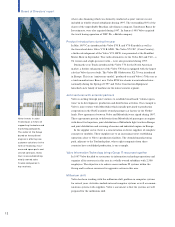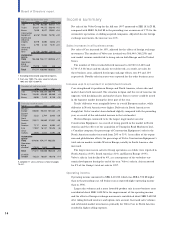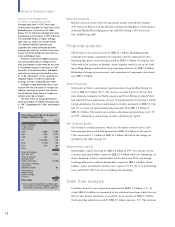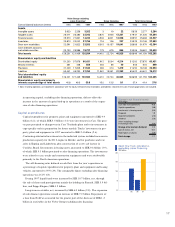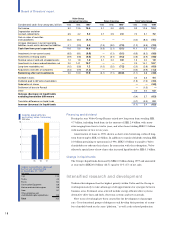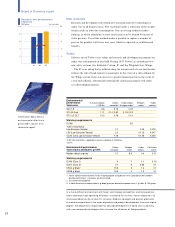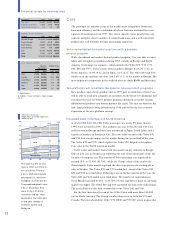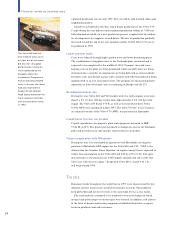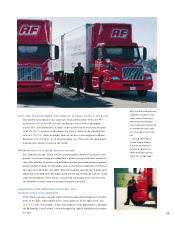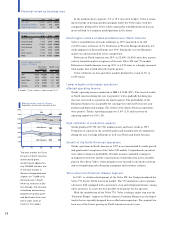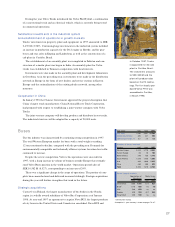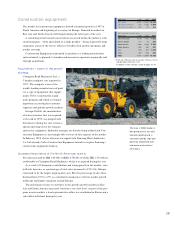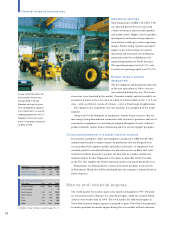Volvo 1997 Annual Report Download - page 22
Download and view the complete annual report
Please find page 22 of the 1997 Volvo annual report below. You can navigate through the pages in the report by either clicking on the pages listed below, or by using the keyword search tool below to find specific information within the annual report.
20
Board of Directors’ report
New m aterials
Research and development involving new materials and new technologies is
under way in all business areas. New materials enable a reduction of the weight,
which results in lower fuel consumption. O ne area being studied is hydro-
forming, in which aluminum or steel chassis parts can be formed by means of
water pressure. Use of this method makes it possible to replace a number of
parts in the product with fewer new ones, which is expected to yield financial
benefits.
Safety
Safety is one of Volvo’s core values and research and development programs are
under way continuously in this field. During 1997 Volvo Cars introduced two
new safety systems: the Inflatable Curtain, IC and the Whiplash Seat, Whips.
The IC is an airbag that is inflated along the interior roof of a car and thereby
reduces the risk of head injuries to passengers in the event of a side collision. In
the Whips system, front seats move in a predetermined pattern in the event of
a rear-end collision, substantially reducing the risk that passengers will suffer
so-called whiplash injuries.
In a m ore difficult environm ent with fewer and stronger competitors and increased cus-
tom er demands, high operating efficiency is essential for survival. Volvo’s objective is to
increase productivity by at least 5% annually. Modular concepts and parallel processes
characterize operations in the areas of product and process development to an ever-higher
degree. The department responsible for concept development in Volvo Cars is work ing
with new advanced technologies that increase the efficiency of Group products.
Information about Volvo’s
environmental efforts are
presented in Volvo’s envi-
ronmental report.
Research and developm ent
expenses
SEK billion
10
8
6
4
2
9795 96
% of net sales 10
8
6
4
2
Environmental
performance Fuel consumption Carbon Hydro carbon Nitrogen Hydro
Volvo cars l/ 100 km monoxide* Nitrogen oxides * oxides* carbons *
S40 1,8 8.6 0.73 0.22
V70 Bi-Fuel 11.1 0.14/ 0.82 0.19/ 0.23
S70 2,5 GLT 10.5 0.78 0.14
Statutory requirements
EU 96 0.5
TLEV (Transitional
Low Emission Vehicle) 2.1 0.25 0.078
LEV(Low Emission Vehicle) 2.1 0.125 0.047
ULEV (Ultra Low Emission Vehicle) 1.06 0.125 0.025
TLEV, LEVand ULEV= applicable emission standards in California.
* g/ km
Environmental performance Carbon Nitrogen Hydro- Particulate
Volvo trucks and buses: g/ kWh monoxide oxides carbons matter
Modern diesel engines10.7 6.3 0.4 0.11
Statutory requirements
EU96 (Euro 2) 4 7 1.1 0.15
EU01 (Euro 3)22.1 5 0.66 0.1
US94 g/ bhph315.5 5 1.3 0.1
US98 g/ bhph 15.5 4 1.3 0.1
1 Values representative for Volvo Trucks’ engine program using diesel fuel in accordance with Swedish
Environmental Class 1. All values are EU certified.
2 EU Commission proposal.
3 In North America the measurement is g/ bhph (gram per braked horsepower hour) 1 g/ kWh= 0.735 g/ bhp.




